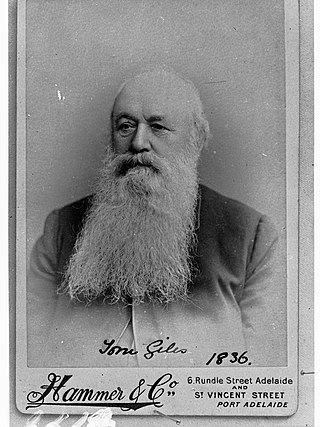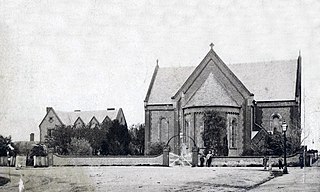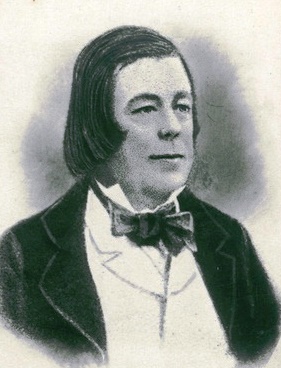Related Research Articles

Augustus Short was the first Anglican bishop of Adelaide, South Australia.

Walkerville is a suburb of Adelaide, South Australia. It lies just north east of the city centre, about 4 kilometres (2.5 mi) from the Adelaide GPO. Walkerville is one of South Australia's most affluent suburbs and in 2012 it was South Australia's second "top earning suburb."

Tom Giles was a business associate of George Anstey and developed pastoral leases on Eyre and Yorke Peninsulas during the 19th century.
George Dove was a long serving Anglican priest in Adelaide, South Australia.
William Richard Pybus was a South Australian organist, pianist and music teacher.
James Pollitt was an Anglican missionary to South America and pioneering minister in South Australia.

Christ Church, North Adelaide is an Anglican church in North Adelaide, South Australia.
Eustace Reveley Mitford was a satirical writer, best known as "Pasquin", prominent in the early days of the Colony of South Australia.
Daniel Garlick was an architect in the early days of South Australia. During his lifetime, his architectural practice names were Garlick & Son and Jackman & Garlick. After his death his name was perpetuated by two rival firms: Garlick & Sibley and then Garlick, Sibley & Wooldridge; and Garlick & Jackman and then Garlick, Jackman & Gooden.
William John Woodcock, generally referred to as W. J. Woodcock or John Woodcock, was an Anglican priest remembered as the first curate of Christ Church, North Adelaide in South Australia.

William Williams was an early settler in the Province of South Australia, known for establishing the Walkerville Brewery and for his work on the Kaurna language. He was Deputy Colonial Storekeeper for some time.
Frederic Slaney Poole, generally referred to as F. Slaney Poole or Canon Poole, was an Anglican priest in South Australia.
George Wright Hawkes SM was a prominent and energetic Anglican churchman and philanthropist in South Australia. He was instrumental in the erection of St Andrew's Church, Walkerville, and St Paul's, Pulteney Street. He was one of the original trustees of St Bartholomew's, Norwood, and St Luke's, Whitmore Square.
St. John's is an Anglican church at the south-east corner of the City of Adelaide dating from 1841. The first building was demolished in 1886 and its replacement opened in 1887.
Rev. Edmund King Miller, invariably known as E. K. Miller, was an Anglican minister in South Australia, the first principal of the Pulteney Street School in Adelaide.
John Fulford was an Anglican priest in Australia.
Rev. Theodore Percival "Percy" Wilson, generally known as T. P. Wilson, was an Anglican priest and author known for his pioneering, albeit brief, work in Adelaide, South Australia.
Rev. John Whitelaw Schoales (1820–1903) was an Anglican priest in the pioneering days of Adelaide, South Australia.

Charles Soward Hornabrook, generally referred to as "C. S. Hornabrook" was an Anglican priest in the colony and State of South Australia, possibly best remembered for his work in Adelaide with St Mary Magdalene's Church and St Peter's College Mission, in Moore street, Adelaide.
John Harrison Packard was a surveyor in the colony of South Australia. He served under G. W. Goyder in the initial survey of Port Darwin.
References
- ↑ "St Mary's Church". The Southern Australian . Vol. IV, no. 222. South Australia. 6 July 1841. p. 3. Retrieved 2 April 2019– via National Library of Australia.
- 1 2 3 "Anglican Parish of St Marys: History" . Retrieved 2 April 2019.
- ↑ "Second Anglican Church". The Advertiser (Adelaide) . South Australia. 7 February 1936. p. 26. Retrieved 2 April 2019– via National Library of Australia.
- ↑ "St Andrews, Walkerville". The Advertiser (Adelaide) . South Australia. 6 May 1925. p. 13. Retrieved 4 April 2019– via National Library of Australia.
- ↑ "Eighty Years' Record - St Mary's, South Road". The Register (Adelaide) . Vol. XCIII, no. 26, 986. South Australia. 11 February 1928. p. 14. Retrieved 4 April 2019– via National Library of Australia.
- ↑ Hopgood, D.J. (14 August 1986). "SOUTH AUSTRALIAN HERITAGE ACT, 1978 Entry of Items on the Register of State Heritage Items" (PDF). The South Australian Government Gazette. Government of South Australia. p. 537. Retrieved 8 August 2019.
- ↑ "St Marys Anglican Church Cemetery and Gates, 1167 South Rd, St Marys, SA, Australia - listing on the now-defunct Register of the National Estate (Place ID 6608)". Australian Heritage Database . Australian Government. 15 May 1990. Retrieved 8 August 2019.
- ↑ "The Week's News". The Adelaide Observer . Vol. XXIX, no. 1583. South Australia. 3 February 1872. p. 7. Retrieved 4 April 2019– via National Library of Australia.
- ↑ "The Late Mr. Mitford". South Australian Register . Vol. XXXVII, no. 8007. South Australia. 16 July 1872. p. 5. Retrieved 4 April 2019– via National Library of Australia.
- ↑ "Eighty Years' Record — St Mary's, South Road". The Register (Adelaide) . Vol. XCIII, no. 26, 986. South Australia. 11 February 1928. p. 14. Retrieved 4 April 2019– via National Library of Australia.